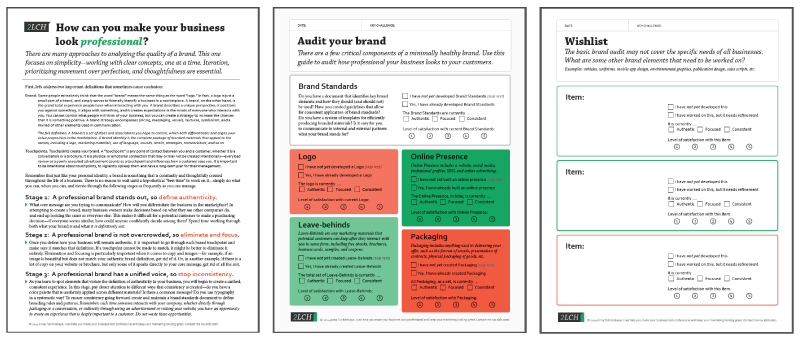There are many approaches to analyzing the quality of a brand. This one focuses on simplicity—working with clear concepts, one at a time, to create a professional-looking business. Iteration, prioritizing movement over perfection, and thoughtfulness are essential.
In a hurry? Download a brand audit worksheet to analyze the health of your current brand »
First, let’s address two important definitions that sometimes cause confusion:
- Brand: Some people mistakenly think that the word “brand” means the same thing as the word “logo.” In fact, a logo is just a small part of a brand, and simply serves to formally identify a business in a marketplace. A brand, on the other hand, is the grand total experience people have when interacting with you. A brand describes a unique perspective; it positions you against something, it aligns with something, and it creates expectations in the minds of everyone who interacts with you. You cannot control what people will think of your business, but you can create a strategy to increase the chances that it is something positive. A brand strategy encompasses pricing, messaging, visuals, textures, symbolism, and a myriad of other elements used in communication.
- The full definition: A brand is a set of ideas and associations you hope to control, which both differentiates and aligns your value proposition in the marketplace. A brand identity is the complete package of branded materials that appeal to the senses, including a logo, marketing materials, use of language, sounds, smells, strategies, nomenclature, and so on.
- Touchpoints: Touchpoints create your brand. A “touchpoint” is any point of contact between you and a customer, whether it is a conversation or a brochure. It is a physical or emotional connection that may or may not be created intentionally—every bad review or a poorly executed advertisement counts as a touchpoint and influences how a customer sees you. It is important to be intentional about touchpoints, to vigilantly upkeep them and have a long-term plan for their management.
Remember that just like your personal identity, a brand is something that is constantly and thoughtfully created throughout the life of a business. There is no reason to wait until a hypothetical “best time” to work on it—simply do what you can, when you can, and iterate through the following stages as frequently as you can manage.
Stage 1: A professional brand stands out, so define authenticity.
What core message are you trying to communicate? How will you differentiate the business in the marketplace? In attempting to create a brand, many business owners make decisions based on what they see other companies do, and end up looking the same as everyone else. This makes it difficult for a potential customer to make a purchasing decision—if everyone seems similar, how could anyone confidently decide among them? Spend time working through both what your brand is and what it is definitively not.
Stage 2: A professional brand is not overcrowded, so eliminate and focus.
Once you define how your business will remain authentic, it is important to go through each brand touchpoint and make sure it matches that definition. If a touchpoint cannot be made to match, it might be better to eliminate it entirely. Elimination and focusing is particularly important when it comes to copy and images—for example, if an image is beautiful but does not match your authentic brand definition, get rid of it. Or, in another example, if there is a lot of copy on your website or brochure, but only some of it speaks directly to your core message, get rid of all the rest.
Stage 3: A professional brand has a unified voice, so stop inconsistency.
As you learn to spot elements that violate the definition of authenticity in your business, you will begin to create a unified, consistent experience. In this stage, pay closer attention to different ways that consistency is created—do you have a color palette that is uniformly applied across different materials? Is there a common message? Do you use typography in a systematic way? To ensure consistency going forward, create and maintain a brand standards document to define branding rules and patterns.
Remember: each time someone interacts with your company, whether directly through packaging or a conversation, or indirectly through seeing an advertisement or visiting your website, you have an opportunity to create an experience that is deeply important to a customer. Do not waste these opportunities.
Ready to begin improving your business? I have created a simple worksheet to help you audit your business’s brand and quickly evaluate what you need to work on.

Two ways to get the worksheet:
- Get it for FREE by downloading it here. No strings attached, I hope it helps! If you do the worksheet, I’d love to hear your comments.
- Choose to pay a small fee for the time it took me to make this worksheet. Please use the form below to do so.
Please contact me. I can guide you through the brand audit, and help you improve your marketing.